Abstract
The cosmopolitan nematode parasites Ascaris lumbricoides, Ascaris suum, and Toxocara canis are closely related phylogenetically, and are all pathogenic to man. In the case of the latter, the antigens released by the tissue-invasive parasitic larvae in vitro ('excretory/secretory' or 'ES' antigens) are routinely used for serodiagnostic purposes. Here we have found, using radioimmunoprecipitation with defined rabbit antiserum, and SDS-PAGE, that there is a significant antigenic similarity between the secreted and somatic antigens of the three nematodes, and have characterized cross-reactive components. Among these is a 14 kD internal protein which has a homologue in all three parasites. This molecule is the subject of an IgG antibody response in Ascaris infection, but there is no measurable response to it in toxocariasis. Lastly, using quantitative immunofluorescence, the antigens exposed on the surface of intact, living, larvae were found to be cross-reactive or specific depending on the developmental stage of the parasites. This means that the surface of tissue-invasive Ascaris larvae bears stage-specific epitopes.
Full text
PDF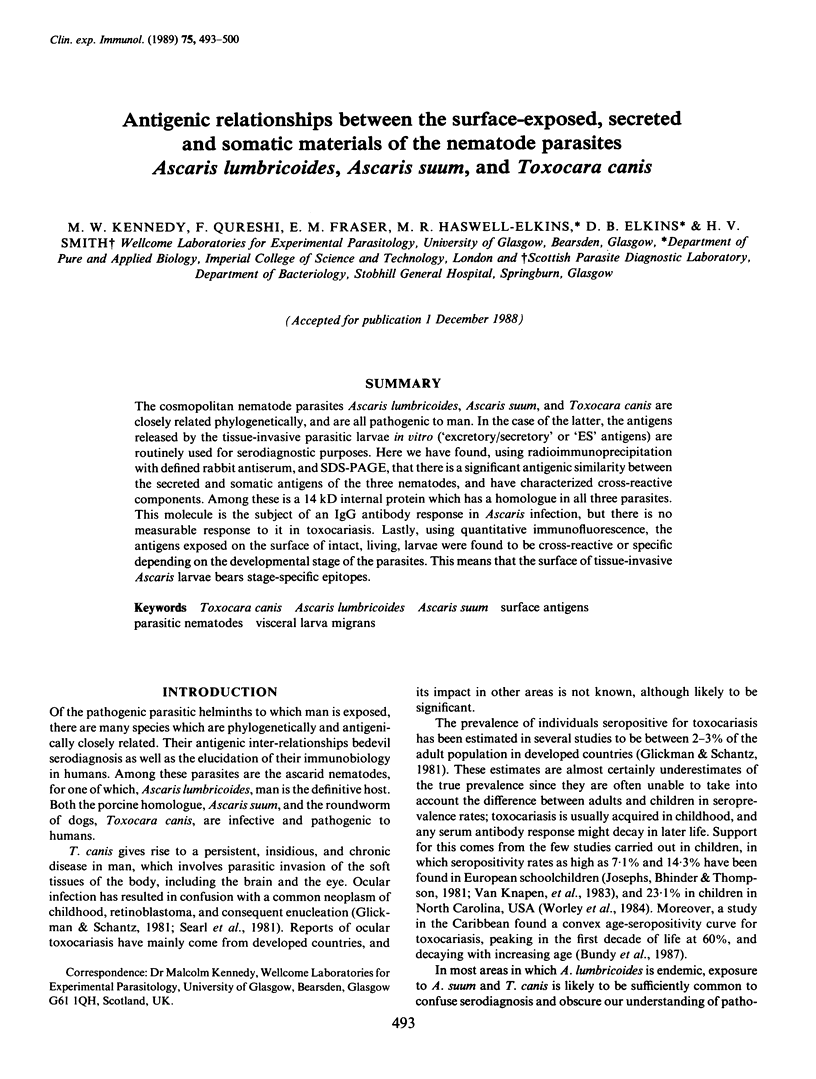
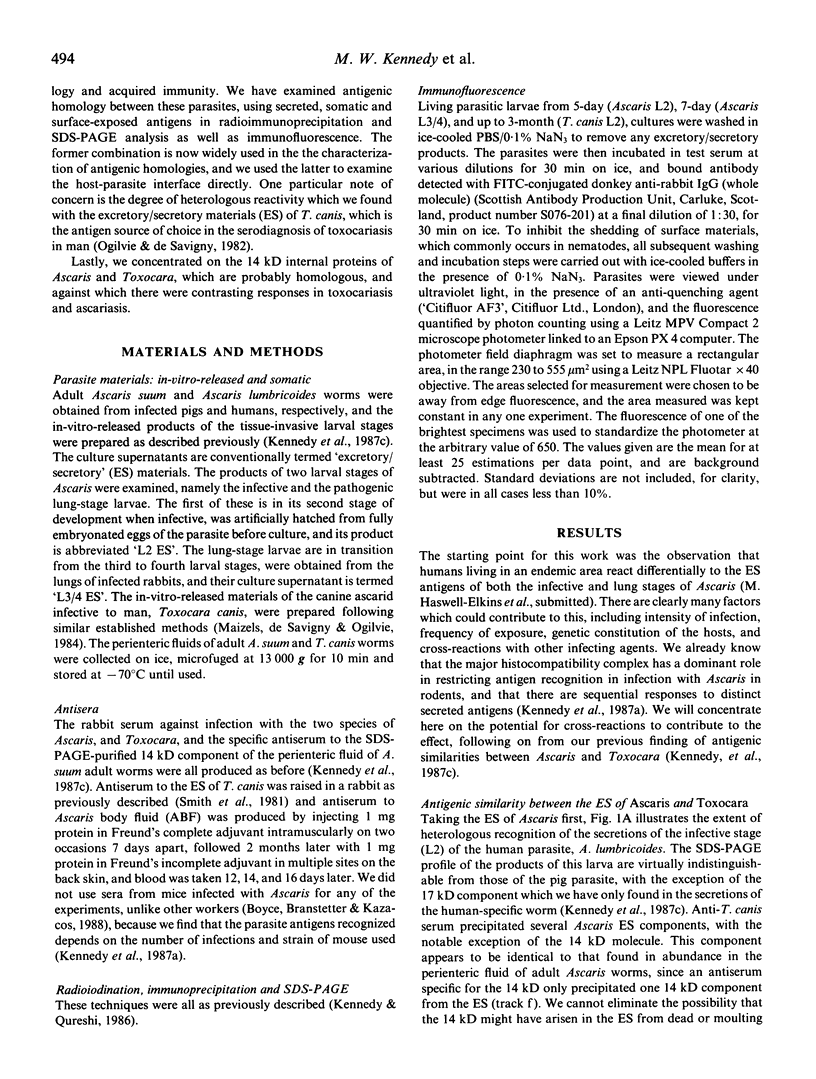
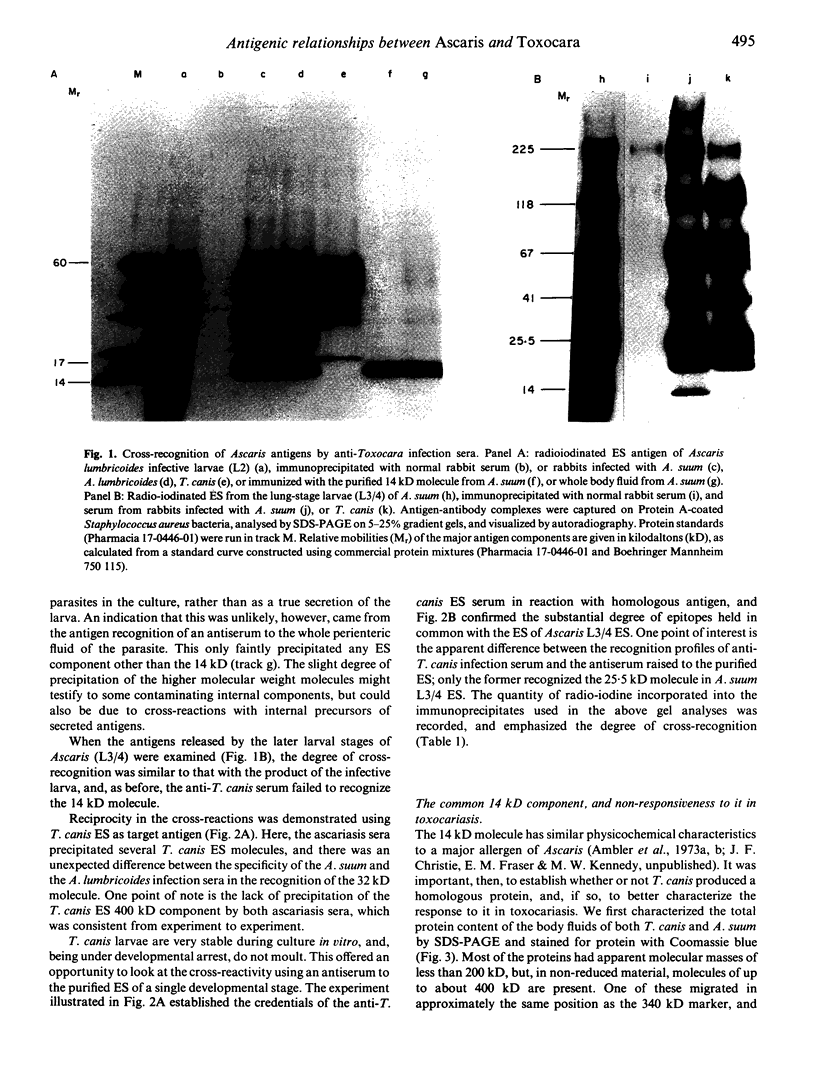
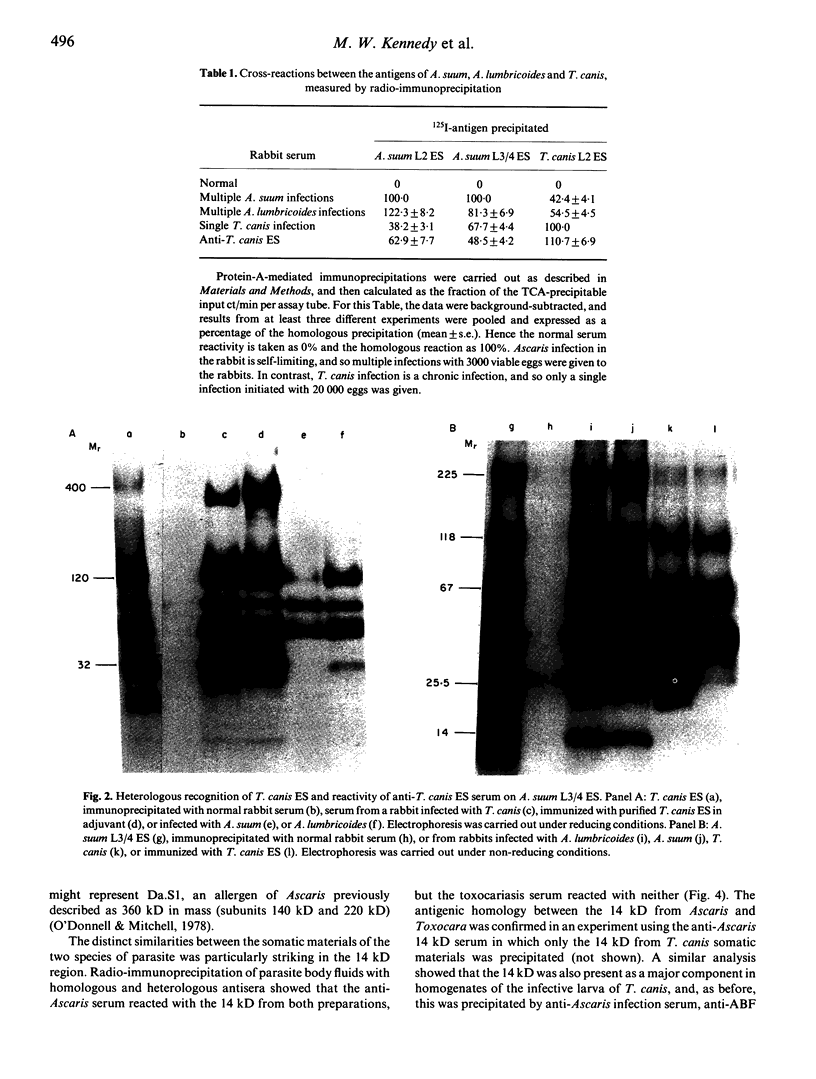
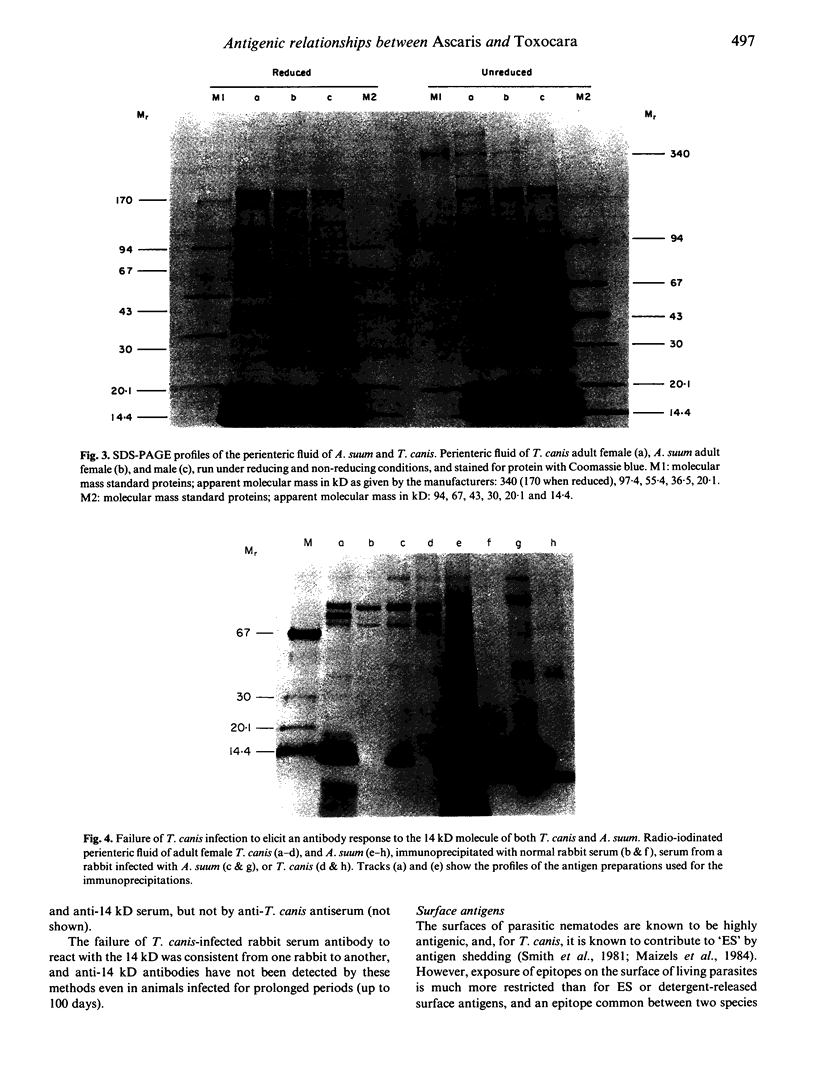
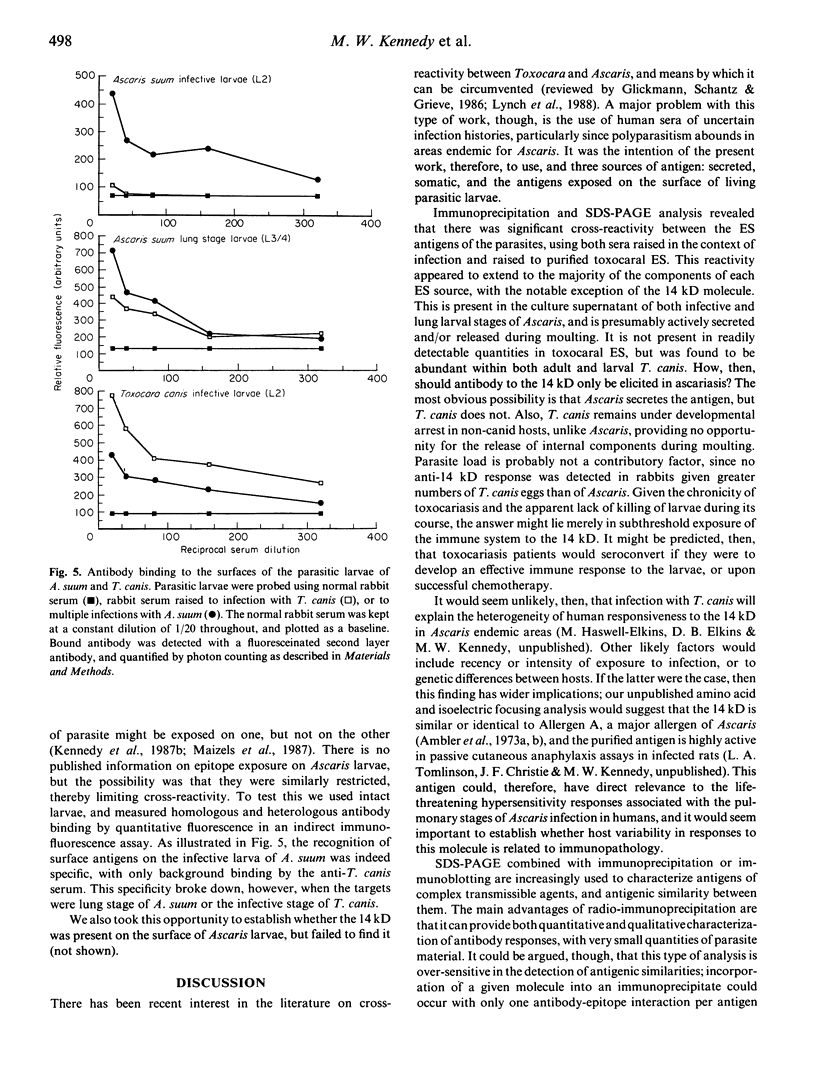
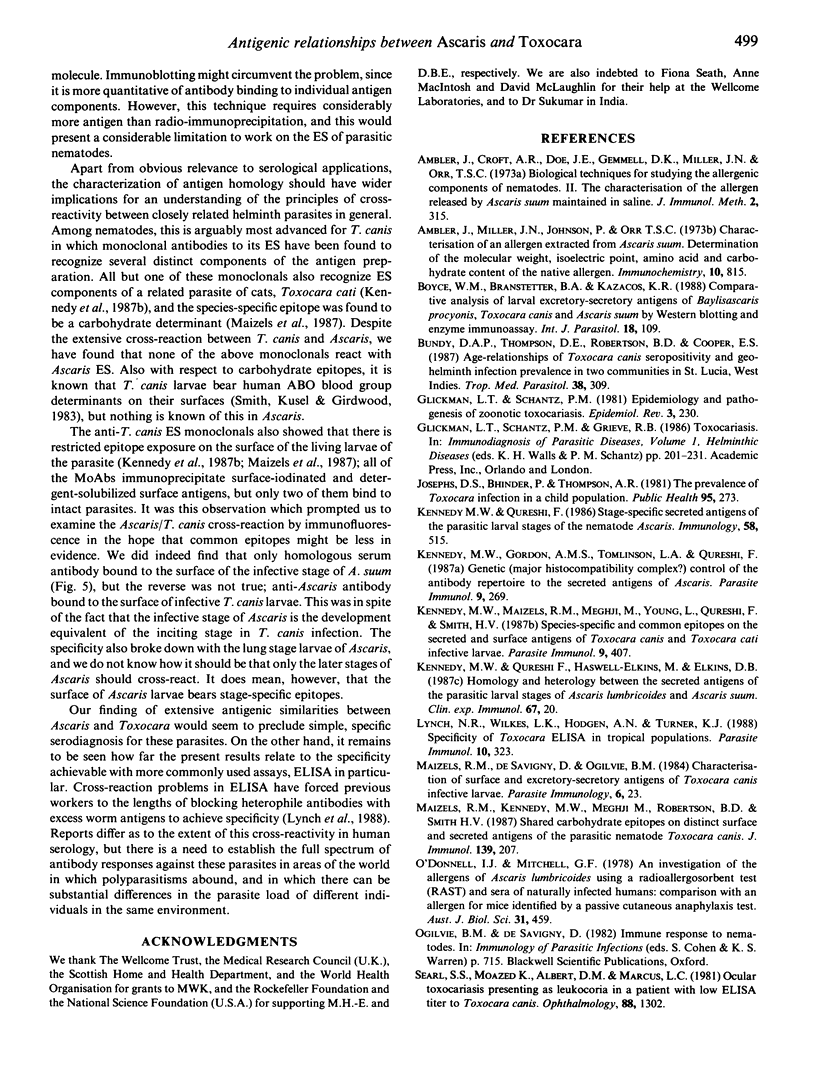
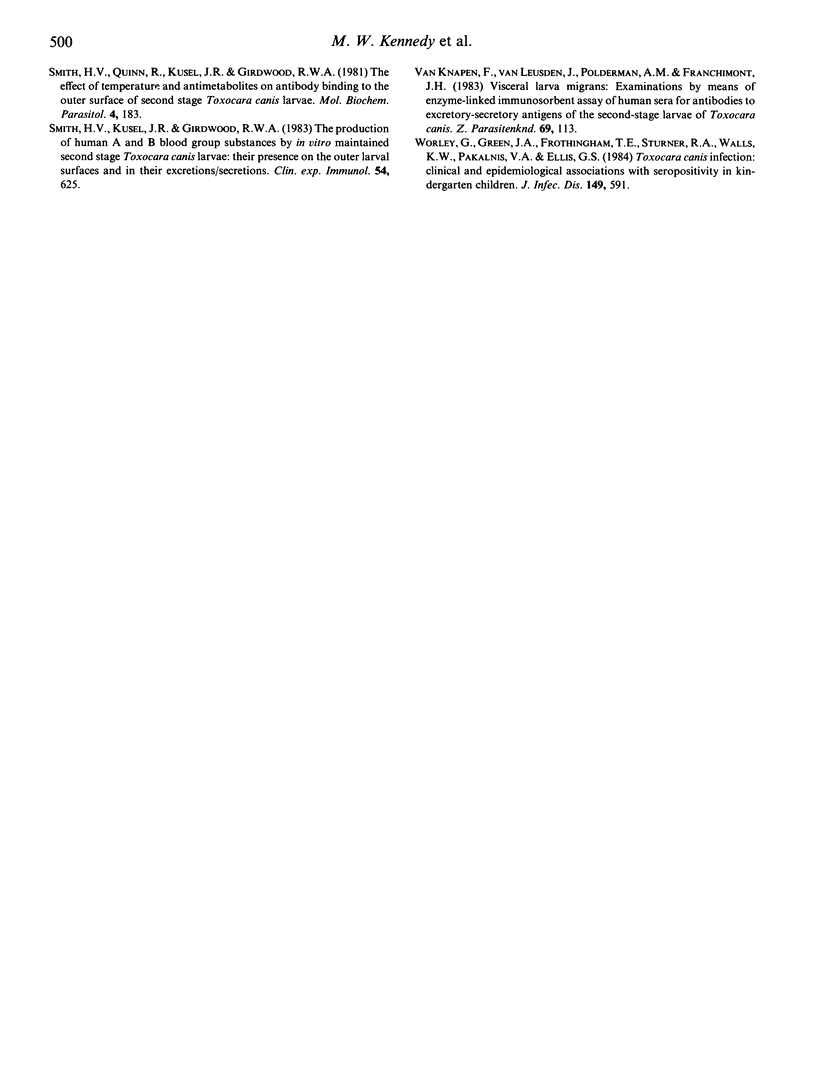
Images in this article
Selected References
These references are in PubMed. This may not be the complete list of references from this article.
- Ambler J., Croft A. R., Doe J. E., Gemmell D. K., Miller J. N., Orr T. S. Biological techniques for studying the allergenic components of nematodes. II. The characterisation of the allergen released by Ascaris suum maintaind in saline. J Immunol Methods. 1973 Apr;2(3):315–323. doi: 10.1016/0022-1759(73)90058-6. [DOI] [PubMed] [Google Scholar]
- Ambler J., Miller J. N., Johnson P., Orr T. S. Characterisation of an allergen extracted from Ascaris suum. Determination of the molecular weight, isoelectric point, amino acid and carbohydrate content of the native allergen. Immunochemistry. 1973 Dec;10(12):815–820. doi: 10.1016/0019-2791(73)90185-7. [DOI] [PubMed] [Google Scholar]
- Boyce W. M., Branstetter B. A., Kazacos K. R. Comparative analysis of larval excretory-secretory antigens of Baylisascaris procyonis, Toxocara canis and Ascaris suum by Western blotting and enzyme immunoassay. Int J Parasitol. 1988 Feb;18(1):109–113. doi: 10.1016/0020-7519(88)90044-6. [DOI] [PubMed] [Google Scholar]
- Bundy D. A., Thompson D. E., Robertson B. D., Cooper E. S. Age-relationships of Toxocara canis seropositivity and geohelminth infection prevalence in two communities in St. Lucia, West Indies. Trop Med Parasitol. 1987 Dec;38(4):309–312. [PubMed] [Google Scholar]
- Glickman L. T., Schantz P. M. Epidemiology and pathogenesis of zoonotic toxocariasis. Epidemiol Rev. 1981;3:230–250. doi: 10.1093/oxfordjournals.epirev.a036235. [DOI] [PubMed] [Google Scholar]
- Josephs D. S., Bhinder P., Thompson A. R. The prevalence of Toxocara infection in a child population. Public Health. 1981 Sep;95(5):273–275. doi: 10.1016/s0033-3506(81)80018-2. [DOI] [PubMed] [Google Scholar]
- Kennedy M. W., Gordon A. M., Tomlinson L. A., Qureshi F. Genetic (major histocompatibility complex?) control of the antibody repertoire to the secreted antigens of Ascaris. Parasite Immunol. 1987 Mar;9(2):269–273. doi: 10.1111/j.1365-3024.1987.tb00506.x. [DOI] [PubMed] [Google Scholar]
- Kennedy M. W., Maizels R. M., Meghji M., Young L., Qureshi F., Smith H. V. Species-specific and common epitopes on the secreted and surface antigens of Toxocara cati and Toxocara canis infective larvae. Parasite Immunol. 1987 Jul;9(4):407–420. doi: 10.1111/j.1365-3024.1987.tb00519.x. [DOI] [PubMed] [Google Scholar]
- Kennedy M. W., Qureshi F., Haswell-Elkins M., Elkins D. B. Homology and heterology between the secreted antigens of the parasitic larval stages of Ascaris lumbricoides and Ascaris suum. Clin Exp Immunol. 1987 Jan;67(1):20–30. [PMC free article] [PubMed] [Google Scholar]
- Kennedy M. W., Qureshi F. Stage-specific secreted antigens of the parasitic larval stages of the nematode Ascaris. Immunology. 1986 Jul;58(3):515–522. [PMC free article] [PubMed] [Google Scholar]
- Lynch N. R., Wilkes L. K., Hodgen A. N., Turner K. J. Specificity of Toxocara ELISA in tropical populations. Parasite Immunol. 1988 May;10(3):323–337. doi: 10.1111/j.1365-3024.1988.tb00224.x. [DOI] [PubMed] [Google Scholar]
- Maizels R. M., Kennedy M. W., Meghji M., Robertson B. D., Smith H. V. Shared carbohydrate epitopes on distinct surface and secreted antigens of the parasitic nematode Toxocara canis. J Immunol. 1987 Jul 1;139(1):207–214. [PubMed] [Google Scholar]
- O'Donnell I. J., Mitchell G. F. An investigation of the allergens of Ascaris lumbricoides using a radioallergosorbent test (RAST) and sera of naturally infected humans: comparison with an allergen for mice identified by a passive cutaneous anaphylaxis test. Aust J Biol Sci. 1978 Oct;31(5):459–487. doi: 10.1071/bi9780459. [DOI] [PubMed] [Google Scholar]
- Searl S. S., Moazed K., Albert D. M., Marcus L. C. Ocular toxocariasis presenting as leukocoria in a patient with low ELISA titer to Toxocara canis. Ophthalmology. 1981 Dec;88(12):1302–1306. doi: 10.1016/s0161-6420(81)34860-x. [DOI] [PubMed] [Google Scholar]
- Smith H. V., Kusel J. R., Girdwood R. W. The production of human A and B blood group like substances by in vitro maintained second stage Toxocara canis larvae: their presence on the outer larval surfaces and in their excretions/secretions. Clin Exp Immunol. 1983 Dec;54(3):625–633. [PMC free article] [PubMed] [Google Scholar]
- Smith H. V., Quinn R., Kusel J. R., Girdwood R. W. The effect of temperature and antimetabolites on antibody binding to the outer surface of second stage Toxocara canis larvae. Mol Biochem Parasitol. 1981 Dec;4(3-4):183–193. doi: 10.1016/0166-6851(81)90017-7. [DOI] [PubMed] [Google Scholar]
- Worley G., Green J. A., Frothingham T. E., Sturner R. A., Walls K. W., Pakalnis V. A., Ellis G. S., Jr Toxocara canis infection: clinical and epidemiological associations with seropositivity in kindergarten children. J Infect Dis. 1984 Apr;149(4):591–597. doi: 10.1093/infdis/149.4.591. [DOI] [PubMed] [Google Scholar]
- van Knapen F., van Leusden J., Polderman A. M., Franchimont J. H. Visceral larva migrans: examinations by means of enzyme-linked immunosorbent assay of human sera for antibodies to excretory-secretory antigens of the second-stage larvae of Toxocara canis. Z Parasitenkd. 1983;69(1):113–118. doi: 10.1007/BF00934015. [DOI] [PubMed] [Google Scholar]






